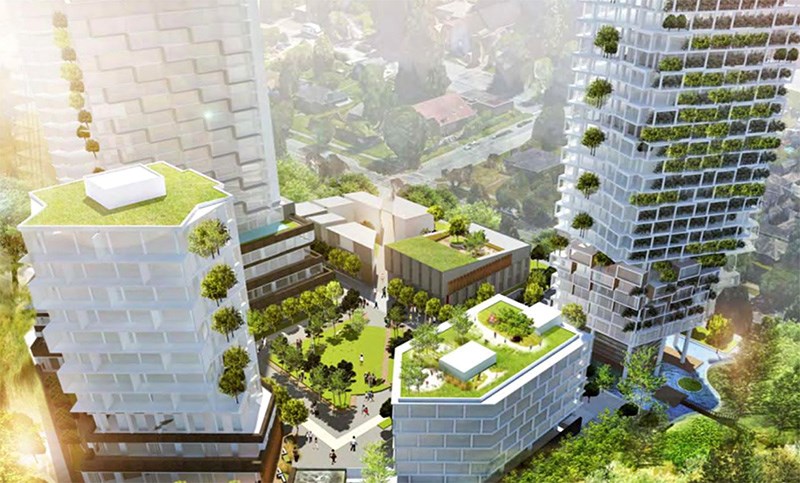While the foundation for a new gateway at the western end of Port Moody is beginning to set, it will still be several years before 10 new buildings begin to rise from the former Andrés Wines’ site at the corner of Clarke Street and Barnet Highway.
At its meeting Tuesday, council gave third reading to bylaw amendments to the five-acre site’s zoning and the city’s official community plan that will pave the way for the massive mixed-use project that will include:
• 418 residential units in a mix of strata condos, rental apartments, independent- and assisted-living units for seniors;
• artists’ live/work studios plus art galleries;
• light industrial spaces;
• retail and commercial units, plus office space;
• a grocery store;
• a boutique hotel;
• and medical and arts centres;
The 10 buildings — ranging from a showpiece 31-storey strata condo tower that includes a six-storey boutique hotel at its base to one 21-storey tower and one 12-storey tower, a six-storey mixed-use building, a three-storey structure and five buildings of two- or three-storeys — will be clustered around a central commons. A diagonal promenade that connects Clarke Street to a restored riparian area flanking Schoolhouse Creek will bisect the project.
The proposal by the property’s owner, Andrew Peller Ltd., received overwhelming support from a broad range of speakers — from the Tri-Cities Chamber of Commerce to local streamkeepers to a representative from the HUB Cycling advocacy group — during the public hearing that preceded Tuesday’s council meeting. But the company’s chair and CEO, John Peller, said there’s much more work to be done before shovels hit the ground.
“It’s a very complex development,” Peller told The Tri-City News, adding once council adopts the bylaw amendments, likely later this yearl, his company will begin the process of finding building partners, noting, “We’re not a developer."
Peller said the outpouring of praise for the project was the culmination of the 14 years of planning and community consultation. He said it was important to listen to the community’s desires and hopes for the property so the wine company — which got its start in Port Moody in 1961 — could leave a positive legacy after it closed its PoMo operation in 2005.
“We take great pride we’re doing something for generations to come,” Peller said.
While some councillors had earlier expressed reservations about the strain the proposed development would put on traffic given its 1.3-km distance to the Moody Centre SkyTrain station, the project’s transportation consultant, Peter Joyce of Bunt & Associates, assured councillors that could be mitigated with a shuttle bus running to and from the station during peak hours, an improved bikeway along Clarke Street, bike and car share programs, incentives for carpooling as well as enhancements to nearby intersections. He also suggested the mixed-use nature of the project will allow many people to live, work and shop there, without having to get in their cars.
“We benefit from the all-together,” he said.
The project’s principal architect, Joost Bakker of Vancouver's Dialogue Design, was especially excited about the 31-storey condo and hotel tower that will feature trees and greenery lacing its exterior walls as well as a green roof. He compared the design to the famous Bosco Verticale — known as the Vertical Forest in English — a pair of residential towers in Milan, Italy.
Peller said his company is committed to making the fanciful architectural renderings a reality, although market conditions could still necessitate tweaks.
“I think the vision, substance and actual details have been committed to,” he said. “We can’t change gears. We’re going to build and find the right people to make it happen.”
What happens next?
According to André Boel, Port Moody's general manager of planning and development, the proponents of the Westport Village will still have to fulfill various requirements before the zoning and OCP bylaw amendments are adopted. These include:
• a development agreement that outlines obligations for on- and off-street amenities, off-site infrastructure upgrades, environmental enhancements, affordable housing and other commitments, including the timing of the delivery of these components;
• housing agreements to secure the market rental, seniors, and below market artist housing components of the project;
• development permits for form and character (including detailed design guidelines), environmental and geotechnical;
• a development variance permit for the flexed creek setback;
• agreement regarding future closure of Vintner Street and sale;
• closure of Vintner Street and sale;
• subdivision and consolidation to create the development parcel;
• an updated Transportation Impact Assessment; and
• details of the operation of the shuttle bus service.



